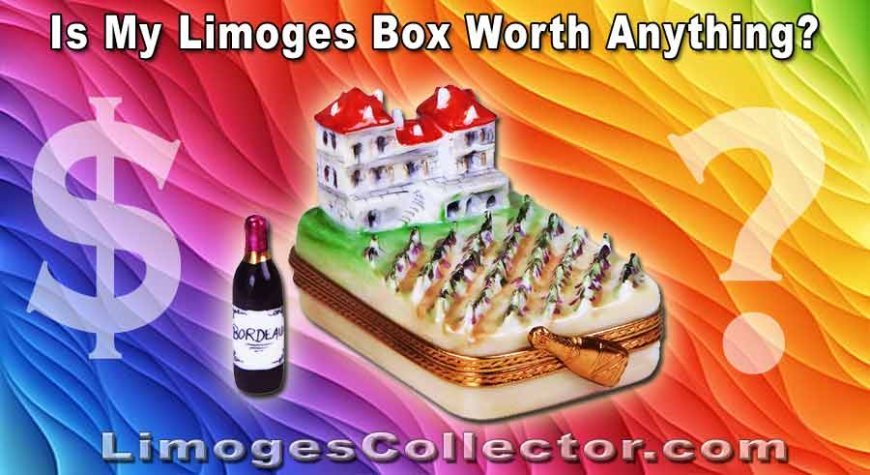Is My Limoges Box Worth Anything? Here's How to Find Out

If you’ve ever opened a drawer and discovered a tiny, beautifully painted porcelain box—or maybe inherited one from a relative—you’ve probably asked yourself: “Is this Limoges box worth anything?” You’re not alone. These charming collectibles are not only lovely to look at, but some can actually be worth a surprising amount of money.
Whether you're a long-time collector or simply curious about a box you've had for years, it helps to understand what makes a Limoges box valuable, and how to tell if yours is one of the special ones.
What Exactly Is a Limoges Box?
Let’s start with the basics. A Limoges box is a small, hand-painted porcelain trinket box that comes from the city of Limoges, France. These miniature treasures are often shaped like animals, books, flowers, or landmarks, and they typically include a tiny metal clasp and hinge.
Each box is a work of art in itself—hand-painted by skilled French artists and often crafted in limited editions. Some people collect them for their beauty, others for their sentimental value, and many because of their potential worth.
So, Is My Limoges Box Worth Anything?
That depends. The value of a Limoges box can vary widely based on several factors. Here's what to look for:
1. Is It the Real Deal?
The first step is checking whether your box is a genuine Limoges box from France. Sadly, there are lots of imitation boxes out there—usually made in China or elsewhere—that don’t carry the same value.
Real Limoges boxes are crafted from fine French porcelain and typically stamped on the bottom with phrases like:
-
“Peint Main” (which means “hand-painted” in French)
-
“Limoges France”
-
Sometimes even the artist’s signature or the name of a reputable workshop like Rochard, Chamart, or Dubarry
If you spot any of these markings, you’re on the right track.
2. How Old Is It?
As with many collectibles, older can mean more valuable. Vintage and antique Limoges boxes—especially those made before the 1980s—are often worth more than newer ones. Why? Because they’re harder to find and were usually crafted with more intricate detail.
But that doesn’t mean a newer box can’t be valuable. Limited-edition releases, boxes made for special events, or unique designs still hold strong value in the collector's world.
3. Is It in Good Condition?
Even the most beautiful Limoges box loses value if it’s chipped, cracked, or missing parts. A working hinge and clasp, vivid paint, and no damage to the porcelain are key.
Take a close look at your box. If it’s in mint condition, it’s far more likely to fetch a good price—especially if it’s rare or part of a collectible series.
Preserving and Protecting Your Limoges Box
Whether you’re collecting for pleasure or investment, preserving your Limoges box is essential to maintaining its value:
-
Store in a dust-free, padded environment away from direct sunlight
-
Handle with clean hands to avoid damaging the paint
-
Avoid over-opening the hinge or putting pressure on the clasp
-
If cleaning is needed, use a dry or slightly damp cloth—never submerge in water
Should You Sell Your Limoges Box?
If you’re considering selling a Limoges box, timing and venue matter. Online marketplaces like eBay can work for some, but knowledgeable collectors often look to established specialty shops like LimogesCollector.com, which focus exclusively on authentic French porcelain pieces.
Selling through a reputable retailer ensures your piece reaches the right audience—collectors who appreciate quality and are willing to pay for it.
4. What’s the Design?
Limoges boxes come in just about every theme you can imagine: tiny teapots, Eiffel Towers, kittens playing with yarn, Santa Claus, suitcases—you name it.
Some themes are more popular (and therefore more valuable) than others. Boxes that depict Paris landmarks, holiday scenes, or animals are often in high demand. If your box includes a surprise element—like a mini porcelain accessory inside—it may be even more valuable.
5. Who Made It?
Some workshops and artists are more collectible than others. For example, boxes made by Rochard Limoges, Artoria, or signed by a known artist often carry extra value.
Collectors sometimes search specifically for these names, which can raise the price significantly. If your box has a signature or company name, it’s definitely worth looking up.
How Much Is It Worth?
Now the big question—how much could your Limoges box be worth?
Prices vary, but here’s a rough guide:
-
Lower-end boxes or newer designs: $30–$80
-
Well-made authentic boxes: $100–$300
-
Rare or limited editions: $300–$1000+
-
Very rare, signed, vintage boxes: Sometimes even more
One of the best ways to get a realistic idea of your box's value is to browse similar ones on trusted websites like LimogesCollector.com, where you’ll find only authentic, high-quality pieces.
Should I Get It Appraised?
If you believe you have a rare or valuable Limoges box, it might be worth having it appraised. Antique dealers, porcelain specialists, or even some collectors’ groups can help evaluate its worth.
Make sure to provide clear photos of the box from all sides, especially the underside where any markings appear. Knowing where and when the box was acquired (if possible) is also helpful.
How to Take Care of Your Limoges Box
Even if you're not planning to sell it right now, keeping your Limoges box in top condition helps preserve its value. Here are a few quick tips:
-
Store it away from direct sunlight to prevent fading
-
Avoid dropping or banging it—porcelain is delicate!
-
Clean gently with a dry or slightly damp cloth
-
Don’t force the hinge or clasp open if it feels stuck
These little boxes are surprisingly durable if cared for properly, and many have lasted generations.
Final Thoughts: More Than Just Porcelain
At the end of the day, a Limoges box is more than just a collectible—it’s a little piece of French artistry and history. Whether it’s worth $50 or $500, it carries charm, craftsmanship, and maybe even some family memories.
So, is your Limoges box worth anything? It very well might be—and even if not, its beauty and sentiment might make it priceless to you.
Q1: What is a Limoges box?
A Limoges box is a small, hand-painted porcelain trinket box made in the Limoges region of France. Known for their intricate designs and delicate craftsmanship, these boxes are often shaped like animals, landmarks, holiday scenes, or other charming objects. They are highly collectible and often feature a hinged lid with a metal clasp.
Q2: How can I tell if my Limoges box is authentic?
To determine authenticity, check the bottom of the box for markings such as:
-
“Peint Main” (hand-painted)
-
“Limoges France”
-
An artist’s signature or workshop stamp (e.g., Rochard, Chamart)
Authentic Limoges boxes are made from fine French porcelain in the Limoges region and are always hand-painted.
Q3: Are Limoges boxes valuable?
Yes, many Limoges boxes can be quite valuable—especially those that are:
-
Authentic and marked accordingly
-
Older or vintage
-
Limited-edition or rare designs
-
In excellent condition
-
Made by known artists or manufacturers
Values can range from $30 to over $1000 depending on these factors.
Q4: How can I find out how much my Limoges box is worth?
You can start by comparing your box to similar ones on trusted websites like LimogesCollector.com. Look for the same design, condition, and markings. For a more accurate assessment, consider having it appraised by an expert or antique dealer.
Q5: What affects the value of a Limoges box?
Several factors influence the value of a Limoges box:
-
Authenticity and origin
-
Age and rarity
-
Condition (no chips, cracks, or faded paint)
-
Design/theme popularity
-
Artist or workshop reputation
-
Special features like surprises inside the box
Q6: Are all Limoges boxes hand-painted?
Genuine French Limoges boxes are always hand-painted. This is one of the key features that sets them apart from imitations. If your box has printed or machine-painted designs, it’s likely not an authentic Limoges piece.
Q7: Where can I sell my Limoges box?
You can sell your Limoges box through:
-
Specialty retailers like LimogesCollector.com (they may offer consignment or buy directly)
-
Online marketplaces such as eBay or Etsy
-
Antique shops or collectible fairs
For the best value, ensure your box is clean, photographed clearly, and accurately described.
What's Your Reaction?


























































